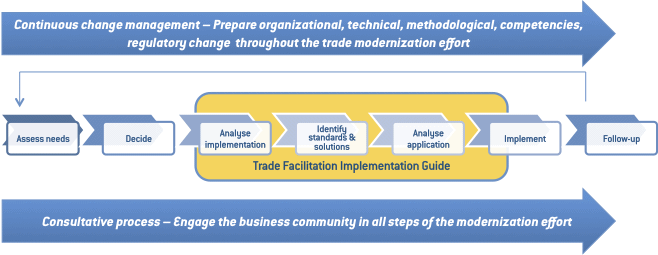The generic approach to TF implementation
The generic approach to trade facilitation implementation is a simplified mapping and description of how to plan for trade facilitation reforms and to monitor their challenges. It was developed using the experience of trade facilitation implementers from different areas of expertise within UN/CEFACT.
Steps of the approach
The approach consists of a sequence of steps that policy makers and managers need to take in the formulation and implementation of trade facilitation initiatives. Such steps range from assessing performance in trading goods and services across borders, to following up on the impact of the reform and the achievement of its objectives. As it is a generic model, adaptation to a specific country or organizational context, needs and capacities is necessary.

Assess needs means identify obstacles to fast, efficient and secure trade transactions. Decide is about what measures to adopt and where they are most needed for trade facilitation. Analyse implementation is to narrow the scope of which processes and procedures are to be improved and in which areas or sectors. It is a crucial step as a phased, sectoral approach is often to be preferred to an horizontal, global one. Identify standards and solutions is the next critical element of the approach, as time, money and resources can be saved by using existing, widely implemented standards, measures and instruments for all aspects of international trade. Analyse application aims at ensuring the best possible use and application of international standards and tools already identified as supporting the objectives of the trade facilitation effort. Implement is about putting into practice the outcome of previous steps, and it suggests a number of perspectives and aspects to be considered. Follow up is about judging the impacts and benefits of measures undertaken. Trade facilitation indicators should be used throughout the process, to guide and evaluate the reform activities. It is furthermore important to consult and cooperate with relevant stakeholders in the reform programme, including both government entities and users from the private sector. If consultative bodies exist in any reform area, they should be used for coordinating the discussion of necessary measures to be adopted.
The approach and the Guide
The Trade Facilitation Implementation Guide (TFIG) focuses on the central steps of the generic approach. The process steps “Assess needs” and “Decide” are considered to be part of the preparatory work before actual implementation can take place. The “Follow-up” step is also excluded, as it is part of the evaluation process that a country needs to carry out at a later stage to assess the actual impact of implemented measures.
